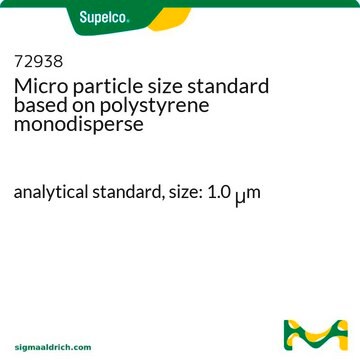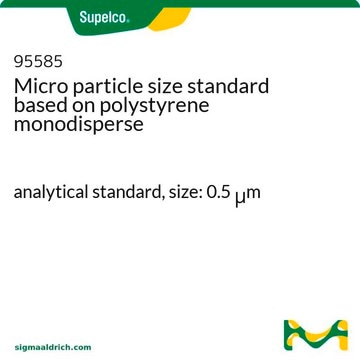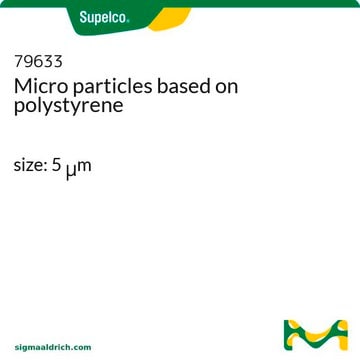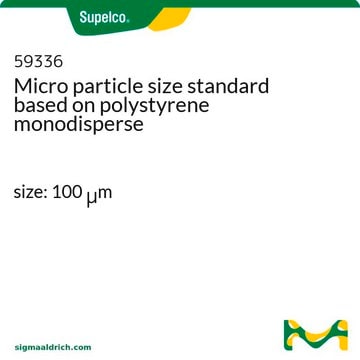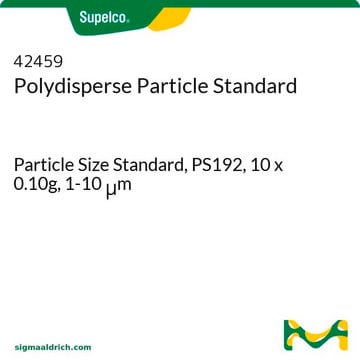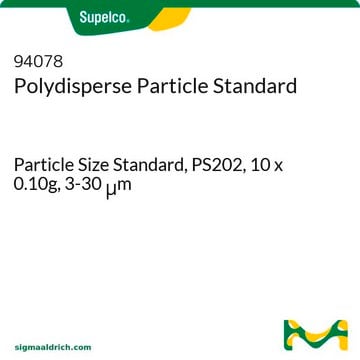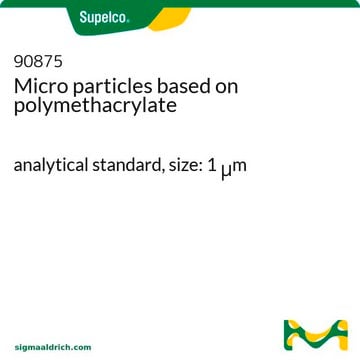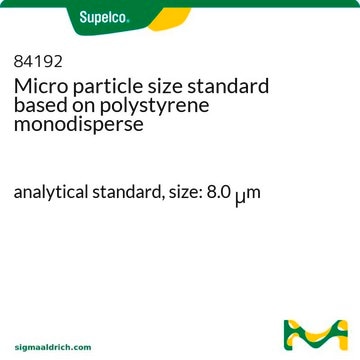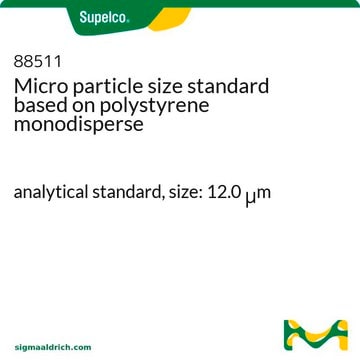80177
Micro particle size standard based on polystyrene monodisperse
analytical standard, size: 2.0 μm
Synonim(y):
Monodisperse polystyrene latex particles (2 μm), Size standards
Zaloguj sięWyświetlanie cen organizacyjnych i kontraktowych
About This Item
Polecane produkty
klasa czystości
analytical standard
Poziom jakości
Postać
aqueous suspension
particles
sieciowanie krzyżowe
0 % cross-linked
stężenie
2% (solids)
wielkość cząstki
2.0 μm std dev <0.05 μm, coeff var <3%
Zastosowanie
glass & ceramic
industrial qc
pharmaceutical
format
neat
temp. przechowywania
2-8°C
Szukasz podobnych produktów? Odwiedź Przewodnik dotyczący porównywania produktów
Opis ogólny
Polystyrene-based monodisperse microparticles (size: 2 μm) are a particle size reference standard, ideal for determining the particle size distribution (PSD) profile of test samples.
Zastosowanie
Used to calibrate, validate and monitor the performance of particle sizers, surface scanning equipment and particle counters.
Monodisperse polystyrene latex particles are also used to investigate their effect on laser-induced breakdown spectroscopy (LIBS) emissions.
Monodisperse polystyrene latex particles are also used to investigate their effect on laser-induced breakdown spectroscopy (LIBS) emissions.
Cechy i korzyści
- Suitable for routine instrument calibration checks and corrections
- Available in 5 mL pack size as a neat sample
Komentarz do analizy
For every lot exact values of particle size and standard deviation are determined with an accuracy of 0.001 μm. The size determination of these particles follows procedures described by National Institute of Standards and Technology (NIST, USA) respectively by the Community Bureau of Reference (BCR), esp.:
- Transmission electron microscopy (TEM)
- Scanning electron microscope
- Light microscopy
- Coulter™ counter with MDF-system
Informacje prawne
Coulter is a trademark of Beckman Coulter, Inc.
This page may contain text that has been machine translated.
Kod klasy składowania
10 - Combustible liquids
Klasa zagrożenia wodnego (WGK)
WGK 3
Temperatura zapłonu (°F)
410.0 °F
Temperatura zapłonu (°C)
210 °C
Środki ochrony indywidualnej
Eyeshields, Gloves
Choose from one of the most recent versions:
Masz już ten produkt?
Dokumenty związane z niedawno zakupionymi produktami zostały zamieszczone w Bibliotece dokumentów.
Klienci oglądali również te produkty
Emmanuel Boateng et al.
Life sciences, 251, 117634-117634 (2020-04-07)
Neuregulin-1β (NRG-1) is a membrane-bound or secreted growth and differentiation factor that mediates its action by binding to ErbB receptors. Circulating levels of NRG-1 are characterized by large inter-individual variability with the range of absolute values covering two orders of
High ErbB3 activating activity in human blood is not due to circulating neuregulin-1 beta
Boateng E, et al.
Life Sciences (2020)
Nasz zespół naukowców ma doświadczenie we wszystkich obszarach badań, w tym w naukach przyrodniczych, materiałoznawstwie, syntezie chemicznej, chromatografii, analityce i wielu innych dziedzinach.
Skontaktuj się z zespołem ds. pomocy technicznej
